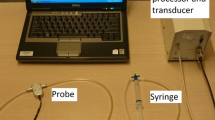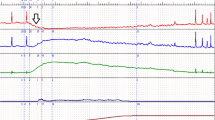Abstract
The aims of the present study were to find the correlation between Valsalva leak-point pressure (VLPP) and cough leak-point pressure (CLPP) and to determine whether the water perfusion maximum urethral closure pressure (MUCP) correlates with VLPP. Seventy-nine women with previously untreated stress urinary incontinence were recruited to participate in a clinical study. Their mean age was 56.4 years, mean BMI was 27.8, and mean parity was 1.9. The mean values of VLPP and CLPP were 50.4 and 52.9 cm H2O, respectively. We did not find statistically significant differences in the mean values of VLPP and CLPP. The mean value of MUCP at rest was 44.2 cm H2O and the mean value of MUCP during maximal Valsalva maneuver was 37.2 cm H2O; with 500 ml of sterile saline in the bladder the difference between them is statistically significant. In the study group (n=79), 56 patients (77%) had low VLPP (≤60 cm H2O), 21 patients (30%) had low MUCP (≤30 cm H2O), and 8 patients had MUCP≤20 cm H2O (all at rest). Of the 56 patients with low VLPP, 16 also had a low MUCP (≤30 cm H2O). This study mainly compares two parameters—the MUCP and the VLPP. Based on our results we can conclude that there is no correlation between these parameters. MUCP measures urethral resistance at rest and VLPP measures urethral resistance during increased intra-abdominal pressure (Valsalva maneuver).



Similar content being viewed by others
References
Abrams P, Cardozo L, Fall M, Griffiths D, Rosier P, Ulmsten U et al (2002) The standardisation of terminology of lower urinary tract function: report from the standardisation sub-committee of the International Continence Society. Neurourol Urodyn 21(2):167–178
DeLancey JOL (1994) Structural support of the urethra as it relates to stress urinary incontinence: the hammock hypothesis. Am J Obstet Gynecol 170:1713–1720
Martan A, Masata J, Svabik K, Drahoradova P, Halaska M, Voigt R (2003) Ultrasound study of the lower urinary tract in continent women. In: Abstract ICS, conference proceedings, Florence
McGuire EJ, Woodside JR, Borden TA, Weiss RM (1981) Prognostic value of urodynamic testing in myelodysplastic patients. J Urol 126:205–209
McGuire EJ, Lytton B, Pepe V, Kohorn EI (1976) Stress urinary incontinence. Obstet Gynecol 47:255–264
Sand P, Bowen LW, Panganiban R, Ostergard DR (1987) The low pressure urethra as a factor in failed retropubic urethropexy. Obstet Gynecol 69:399–402
Lose G, Brostrom S (2002) Low-pressure urethra in women: what does it mean and what can it be used for? Int Urogynecol J Pelvic Floor Dysfunct 13:215–217
American Urogynecology Society (1995) Intrinsic sphincter deficiency: a clinical opinion. AUGS Q Rep 13:2
Pajoncini C, Costantini E, Guercini F, Porena M (2002) Intrinsic sphincter deficiency: do the maximum urethral closure pressure and the Valsalva leak-point pressure identify different pathogenic mechanisms? Int Urogynecol J Pelvic Floor Dysfunct 13:30–35
Bump RC, Elser DM, Theofrastous JP, McClish DK, the Continence Program for Women Research Group (1995) Valsalva leak point pressures in women with genuine stress incontinence: reproducibility, effect of catheter caliber, and measurements of urethral resistance. Am J Obstet Gynecol 13:551–557
Theofrastous JP, Cundiff GW, Harris RL, Bump RC (1996) The effect of vesical volume on Valsalva leak point pressures in women with genuine stress urinary incontinence. Obstet Gynecol 87:711–714
Swift SE, Utrie JW (1996) The need for standardization of the Valsalva leak-point pressure. Int Urogynecol J Pelvic Floor Dysfunct 7:227–230
Jakobsen H, Veden P, Anderson JT (1987) Objective assessment of urinary incontinence: an evaluation of three different pad-weighing test. Neurourol Urodyn 6:325–330
Dietz HP, McKnoulty L, Clarke B (1999) Translabial color doppler for imaging in urogynecology: a preliminary report. Ultrasound Obstet Gynecol 14(2):144–147
Dietz HP, Clarke B (2001) Translabial color Doppler urodynamics. Int Urogynecol J Pelvic Floor Dysfunct 12(5):304–307
Mašata J, Martan A, Halaška M, Otčenášek M, Voigt R (2001) Detection of Valsalva leak point pressure with colour Doppler—new method for routine use. Neurourol Urodyn 20:494–496
Raz S, Erikson DR (1992) SEAPI-QMN incontinence classification system. Neurourol Urodyn 11:187
Abrams P, Blaivas JG, Stanton SL, Andersen JT (1988) The International Continence Society committee on standardization of terminology: the standardization of terminology of lower urinary tract function. Scand J Urol Nephrol 1145:5–19
McGuire EJ, Woodside JR (1981) Diagnostic advantages of fluoroscopic monitoring during urodynamic evaluation. J Urol 125:830–834
Bump RC, Coates KW, Cundiff GW, Haris RL, Weidner AC (1997) Diagnosis intrinsic sphincter deficiency: comparing urethral closure pressure, urethral axis, and Valsalva leak point pressures. Am J Obstet Gynecol 177:303–310
Zmrhal J, Horčička L, Lochman P (2001) Dynamische Tests des urethralen Verschlussmechanismus und Beckenboden. Zentralbl Gynakol 123:158–161
Nager CW, Schulz JA, Stanton SL, Monga A (2001) Correlation of urethral closure pressure, leak-point pressure and incontinence severity measures. Int Urogynecol J Pelvic Floor Dysfunct 12:395–400
Sultana CJ (1995) Urethral closure pressure and leak-point pressure in incontinent women. Obstet Gynecol 86:839–842
Swift SE, Ostergard DR (1995) A comparison of stress leak point pressure and maximum urethral closure pressure in patients with genuine stress incontinence. Obstet Gynecol 85:704–708
Theofrastous JP, Bump RC, Elser DM, Wyman JF, McClish DK (1995) Correlation of urodynamic measures of urethral resistance with clinical measure of incontinence severity in women with pure genuine stress incontinence. Am J Obstet Gynecol 173:407–414
Nitti VW, Combs AJ (1996) Correlation of Valsalva leak point pressure with subjective degree of stress urinary incontinence in women. J Urol 155:281–285
Feldner PC Jr, Bezerra LR, de Castro RA, Sartori MG, Baracat EC, de Lima GR, Girao MJ (2004) Correlation between valsalva leak point pressure and maximal urethral closure pressure in women with stress urinary incontinence. Int Urogynecol J Pelvic Floor Dysfunct 15:194–197
Author information
Authors and Affiliations
Corresponding author
Additional information
This work was supported by the Grant Agency of the Ministry of Health of the Czech Republic, grant NH 7378-3.
Rights and permissions
About this article
Cite this article
Martan, A., Mašata, J., Petri, E. et al. Weak VLPP and MUCP correlation and their relationship with objective and subjective measures of severity of urinary incontinence. Int Urogynecol J 18, 267–271 (2007). https://doi.org/10.1007/s00192-006-0140-8
Received:
Accepted:
Published:
Issue Date:
DOI: https://doi.org/10.1007/s00192-006-0140-8




